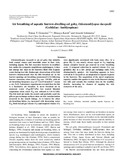Air breathing of aquatic burrow-dwelling eel goby, Odontamblyopus lacepedii (Gobiidae: Amblyopinae)
- Global styles
- MLA
- Vancouver
- Elsevier - Harvard
- APA
- Help

Download URL
jeb.biologists.orgDate
2006Page views
1,797ASFA keyword
AGROVOC keyword
Taxonomic term
Metadata
Perlihat publikasi penuh
Share
Abstract
Odontamblyopus lacepedii is an eel goby that inhabits both coastal waters and intertidal zones in East Asia, including Japan. The fish excavates burrows in mudflats but, unlike the sympatric amphibious mudskippers, it does not emerge but stays in the burrows filled with hypoxic water during low tide. Endoscopic observations of the field burrows demonstrated that the fish breathed air in the burrow opening; air breathing commenced 1.3 h following burrow emersion, when water PO2 was ∼2.8 kPa, with an air-breathing frequency (fAB) of 7.3±2.9 breaths h–1 (mean ± s.d., N=5). Laboratory experiments revealed that the fish is a facultative air breather. It never breathed air in normoxic water (PO2=20.7 kPa) but started bimodal respiration when water PO2 was reduced to 1.0–3.1 kPa. The fish held air inside the mouth and probably used the gills as gas-exchange surfaces since no rich vascularization occurred in the mouth linings. As is known for other air-breathing fishes, fAB increased with decreasing water PO2. Both buccal gas volume (VB) and inspired volume (VI) were significantly correlated with body mass (Mb). At a given Mb, VI was nearly always equal to VB, implying almost complete buccal gas renewal in every breathing cycle. A temporal reduction in expired volume (VE) was probably due to a low aerial gas exchange ratio (CO2 elimination/O2 uptake). Air breathing appears to have evolved in O. lacepedii as an adaptation to aquatic hypoxia in the burrows. The acquisition of the novel respiratory capacity enables this species to stay in the burrows during low tide and extends the resident time in the mudflat, thereby increasing its chances of tapping the rich resources of the area.
Suggested Citation
Gonzales, T. T., Katoh, M., & Ishimatsu, A. (2006). Air breathing of aquatic burrow-dwelling eel goby, Odontamblyopus lacepedii (Gobiidae: Amblyopinae). Journal of Experimental Biology , 209(6), 1085-1092. https://doi.org/10.1242/jeb.02092
Type
ArticleISSN
0022-0949; 1477-9145Koleksi
- Journal Articles [1258]


